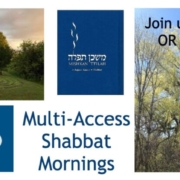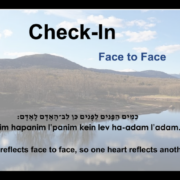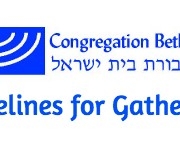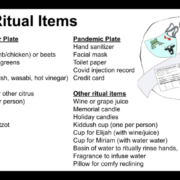In this week’s parsha, Shlach, the scouts go to peek at the Land of Promise. They return with a giant bunch of grapes, so big it needs to be carried by two men on a carrying frame. And most of them say: nah, there’s no way we can conquer that land. The people who live there are giants. We felt like grasshoppers next to them, and we must have looked like grasshoppers in their eyes. We can’t do this.
And God gets angry, and says: because y’all don’t trust in Me, or maybe because y’all don’t trust in yourselves, fine, let’s make it a self-fulfilling prophecy: you can’t do this. This whole generation is going to die here in the wilderness, except for the two people who believed in this enterprise. They’ll lead the next generation into the land of promise. You don’t feel up to it? Now you can’t even try.
If all goes according to plan, I’m sharing these words with you from our first multi-access (a.k.a. hybrid) Shabbat service since the pandemic began some fifteen months ago. When the pandemic started, we went digital, like everyone else. It took us a while to find our feet, but we figured out how to pray together, how to celebrate and mourn together, how to learn together, how to be a community together over Zoom.
Now we’re standing at the edge of another paradigm shift. Many of you have told me how much it meant to you to be able to participate in the spiritual life of our community from home — even from afar. Congregants who long ago moved away joined us for shiva minyanim or Shabbat services. Family members in other states, even in other countries on the far side of the world, joined us for the Days of Awe and Pesach.
As we return to offering some onsite programming, like this morning’s Shabbat services, we’re met with a choice. We could go back to the way things were before, and stop offering an option for digital participation. Or, we can try to figure out how to chart a new path so that both the “roomies” and the “zoomies” are full participants in our community. So that those who are homebound don’t lose access to what we do.
But it’s not just about ensuring that if one of us is homebound or doing a stint in a rehab facility we can still watch CBI’s services as though they were on tv. The real challenge is figuring out how “zoomies” can be full participants. How we can all see each other, whether onsite or online. How all of our voices can be heard, whether onsite or online. How we can all count in the minyan, whether onsite or online.
This is a tall order. It’s going to require some technological infrastructure, which costs money. And it may lead to a fundamental redefining of what it means to be “in community,” what it means to be “together.” That’s not just us, by the way: that’s the whole Jewish world. None of the classes I took in rabbinical school exactly prepared me for this… except inasmuch as they taught me that Judaism has weathered changes before.
It is tempting to be like the scouts: to say, nope, this is too hard, there’s no way we can do this. One bunch of grapes is as big as a black bear, we are not up to this, we feel like grasshoppers. The fact that our forebears in Torah said exactly that tells me that it’s a natural human impulse. It’s normal to feel afraid, faced with an enormous new challenge we’ve never before imagined being able to try to face.
And — as I was discussing with our b-mitzvah students a few days ago — because those scouts didn’t use their ometz lev, their strength of heart, the whole k’hillah suffered. Courage and community are two of the Jewish values we’ve been studying during this pandemic year. These values are part of their Jewish toolbox — and ours. If we want our k’hillah to flourish, we need to cultivate our ometz lev.
It will take a while for us to find our feet in this new chapter. I imagine we’ll have new and different technological challenges, and some personal and spiritual ones, too. If the tenth member of the minyan is on Zoom, will we all feel comfortable counting that person for kaddish? If someone’s joining us from another time zone, will they feel weird joining our evening prayers while the sun is rising where they are?
But if we bring hope and courage to bear, I’m confident that we can navigate a path through. This may not be exactly the Land of Promise we expected, but I believe it has gifts for us. And who knows: maybe when humanity has spread to the stars, Jewish space explorers will look back on the pandemic of 2020 as the moment when our sense of sacred place and time began to evolve into what it needed to become.
This is the d’varling that Rabbi Rachel offered at Shabbat morning services this weekend (cross-posted to Velveteen Rabbi.)


